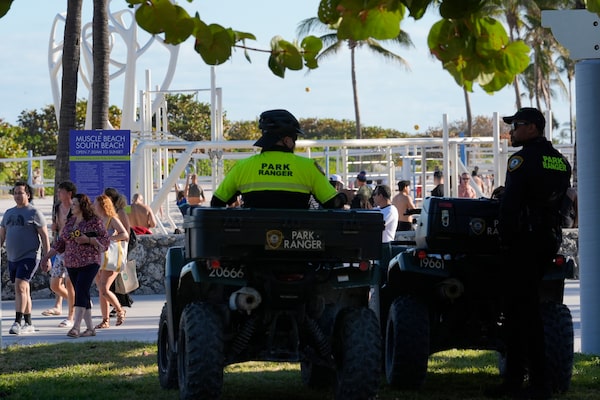
Miami Beach park rangers watch over crowds on Feb. 27 in Miami Beach, Fla.Marta Lavandier/The Associated Press
Gus Carlson is a U.S.-based columnist for The Globe and Mail
There’s an affliction many northerners get when they arrive in the tropics for spring break vacation. It’s called stupid flu, and it causes otherwise reasonable and respectful people to act in ways that are neither.
Maybe it’s the sun, or the salt air, or the salted margaritas – or all of the above. Whatever it is, after years of damage and disruption caused by drunken, disorderly northern nitwits, the City of Miami Beach is taking a pre-emptive hard line to treat the cause of stupid flu, not just the symptoms, with an aggressive social-media campaign, a wide range of beach-strip restrictions and bulked-up police presence.
It’s about time. Last year Miami Beach declared a state of emergency – the third consecutive year it enacted such measures – to control wild partiers who made a mess of the city. This year, community leaders hope, will be different.
“You come here, you have a good time, you behave, we will invite you back,” Miami Beach Police Chief Wayne A. Jones told the local NBC affiliate. “You come here, you break the law, we’re likely gonna arrest you.”
As much as the crackdown makes sense to any reasonable person, measures like these are an economic razor’s edge for high-profile destinations such as Miami Beach, Fort Lauderdale and Orlando. These places rely heavily on tourism and hospitality as an economic engine, but spring break carnage in recent years has skewed the risk-reward equation.
For years, many cities, facing pressure from taxpaying residents who foot the cleanup bills, have said they don’t want spring breakers any more because they are more trouble than they’re worth. As Florida’s full-time population grows, the clash between residents and spring breakers is likely to get worse. Florida is now the fastest-growing state, with 22 million people. It is expected to reach 30 million in the next decade.
Still, the economic impact numbers are compelling. Orlando, for example, saw 7.3 million spring break visitors last year. This generated more than US$1-billion in revenue for the area during the period, which runs roughly from early March to mid-April.
For smaller coastal communities, the surge of spending during those few weeks can account for 20 per cent of annual revenue or more, a critical infusion of prosperity for small economies whose most valuable assets are beaches and tiki bars. Estimates suggest the average college student spends more than US$1,000 on spring break vacations, much of it on food and beverages – in some cases, mostly beverages.
Canadians are big contributors to the seasonal boom. Florida is the most popular destination for Canadian spring breakers.
There is no easy answer to the dilemma created when demand is so strong for what an area has to offer that its popularity becomes its Achilles’ heel. But places such as Miami Beach need to keep trying to solve the riddle.
The city’s new social-media video campaign takes an interesting peer-to-peer tack. Its message, “We are breaking up with you,” is aimed at would-be rowdies. The campaign features sombre young locals chiding visitors who “want to get drunk in public and ignore laws” and shows footage of chaos from last year’s break, calling the incidents “our breaking point” with such nonsense.
The effort has teeth beyond the video. The city is implementing curfews and random bag checks, restricting beach access, increasing DUI checkpoints and restricting parking – even raising fees to US$100 a day in some instances. Law enforcement is on high alert, patrolling extended hours and using drone technology to monitor activity.
Despite the sabre-rattling, spring breakers are gathering on Ocean Drive on Miami Beach’s South Beach, along the Route A1A strip in Fort Lauderdale and on countless other beachfront stretches of Florida’s coastline as the daytime temperatures hover around 26 degrees and the warm waters beckon.
Around the poolside bar at the Clevelander, the cradle of spring break on South Beach, there is some skepticism that the new measures will dampen the spirits of revelers freed from winter’s grip for a few days of fun and funnels in the sun. But there is acknowledgment the city means business this time.
So far, there is no vaccination for stupid flu, so those who choose Florida as their spring break destination need to pay attention to what’s going on here before they arrive, and adjust their expectations accordingly. It’s no vacation looking at the sun and surf through a door with bars.